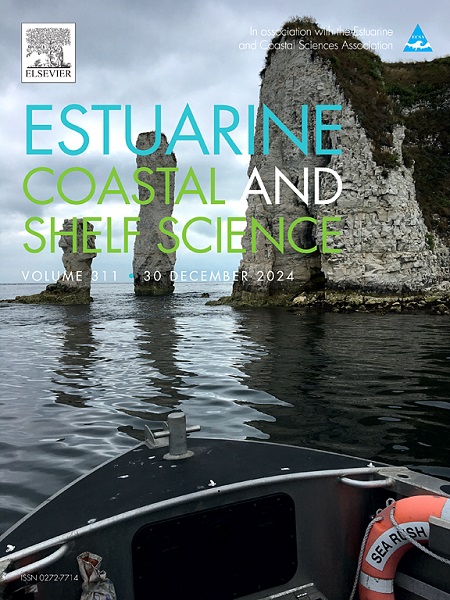基于水文泥沙和植被动态的盐沼景观长期模拟:评估未来稳定性
IF 2.6
3区 地球科学
Q1 MARINE & FRESHWATER BIOLOGY
引用次数: 0
摘要
盐沼在海岸保护和生态系统功能中发挥着重要作用,但受到海平面上升和沉积物供应减少的威胁日益严重。这些压力源破坏了植被动态和水沙动态之间的平衡,可能导致景观突变。本研究基于互花米草、芦苇和沙豆科植物的生命周期建立了植被动力学模型,并将其与Delft3D Flexible Mesh的水动力和形态动力学模块相结合。利用具有代表性的苏中滩涂参数,在不同的SLR和近海悬沙情景下进行了50年的模拟。结果显示物种特有的恢复力和对环境压力的反馈。米草属植物对高SLR和低悬浮沙浓度(SSC)表现出较强的耐受性,通过捕集泥沙有效地稳定了滩涂。相比之下,禾草和芦苇对胁迫更为敏感,在胁迫下表现出快速下降或退缩。植被自组织塑造了高程格局,密集的植被促进了沉积,而溪边地带仍然容易受到侵蚀。在中等条件下,沼泽分区保持稳定,但极端情况导致破碎化和不可逆转的转变。该研究表明,将植被动态与水文泥沙模型相结合,可以捕获对盐沼演变至关重要的长期生物地貌反馈。有效的管理应结合生态和工程方法,将减排与适应性规划相结合,以增强沼泽在未来气候变化下的恢复能力。本文章由计算机程序翻译,如有差异,请以英文原文为准。
Long-term simulation of saltmarsh landscape based on hydro-sediment and vegetation Dynamics: Assessing future stability
Salt marshes play critical roles in coastal protection and ecosystem functioning but are increasingly threatened by sea level rise (SLR) and reduced sediment supply. These stressors disrupt the balance between vegetation dynamics and hydro-sediment dynamics, potentially leading to abrupt landscape transitions. In this study, we developed a vegetation dynamics model based on the life cycles of Spartina alterniflora, Phragmites australis, and Suaeda salsa, and coupled it with the hydrodynamic and morphodynamic modules of Delft3D Flexible Mesh. Using parameters representative of central Jiangsu's tidal flats, we conducted 50-year simulations under varying SLR and offshore suspended sediment scenarios. Results show species-specific resilience and feedbacks to environmental stress. Spartina exhibits strong tolerance to high SLR and low suspended sediment concentration (SSC), effectively stabilizing tidal flats through sediment trapping. In contrast, Suaeda and Phragmites are more sensitive, showing rapid decline or retreat under stress. Vegetation self-organization shapes elevation patterns, with dense vegetation promoting accretion and creek-edge zones remaining erosion-prone. Under moderate conditions, marsh zonation remains stable, but extreme scenarios lead to fragmentation and irreversible shifts. This study demonstrates that coupling vegetation dynamics with hydro-sediment modeling captures long-term biogeomorphic feedbacks critical to salt marsh evolution. Effective management should integrate ecological and engineering approaches, combining emission reduction with adaptive planning to enhance marsh resilience under future climate change.
求助全文
通过发布文献求助,成功后即可免费获取论文全文。
去求助
来源期刊
CiteScore
5.60
自引率
7.10%
发文量
374
审稿时长
9 months
期刊介绍:
Estuarine, Coastal and Shelf Science is an international multidisciplinary journal devoted to the analysis of saline water phenomena ranging from the outer edge of the continental shelf to the upper limits of the tidal zone. The journal provides a unique forum, unifying the multidisciplinary approaches to the study of the oceanography of estuaries, coastal zones, and continental shelf seas. It features original research papers, review papers and short communications treating such disciplines as zoology, botany, geology, sedimentology, physical oceanography.

 求助内容:
求助内容: 应助结果提醒方式:
应助结果提醒方式:


